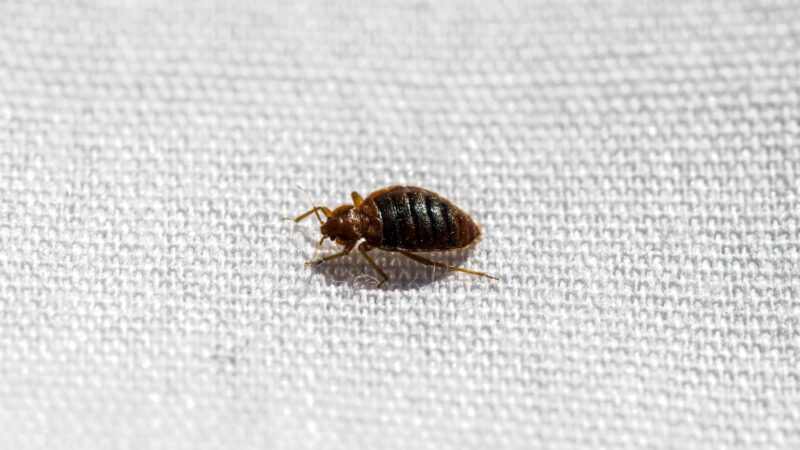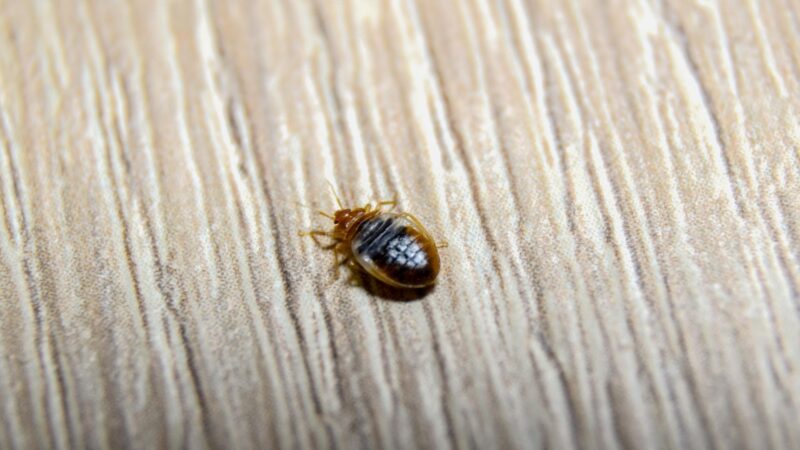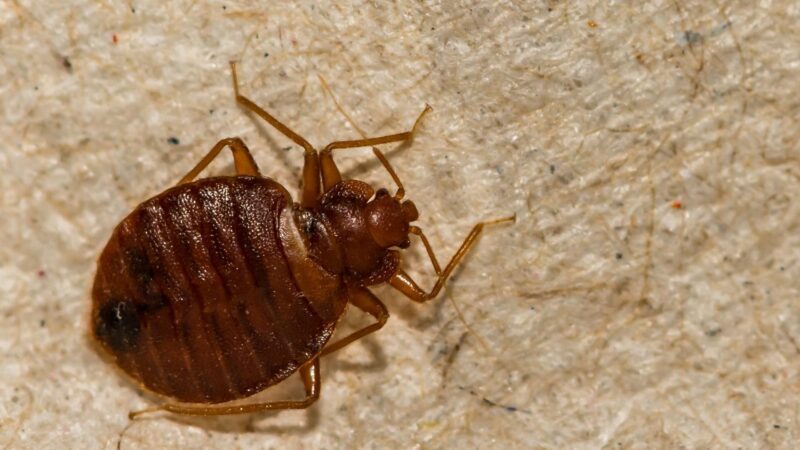Bed bugs are unique among parasites as they don’t consume leftover crumbs, dead skin, or organic waste. Sadly, these tiny, red-brownish pests only crave human blood.
If it’s not available, they can still survive even for a year. This sign of resilience is not good as they leave a red, itchy welt after biting someone’s skin.
How long can bed bugs live without food? Bed bugs can live up to 15 months without blood meal under low temperatures like 50°F. However, under higher temperatures and humidity (78°F), they can live on without feeding for just 3 months.
At room temperature, these bugs can last for 3 to 5 months without food. Apart from temperature, the duration of survival without food also depends on the age of the bed bugs.
Adult ones can be hardy, but the young have a low survival rate because they’re not fully developed.
But don’t be threatened by the resiliency of bed bugs. To eliminate them, you have to know further about their behavior by reading the rest of the article.
Do Bed Bugs Die Without Food?

Some factors affect how bed bugs don’t die without food. First and foremost, surviving without food is not applicable to young bugs since they’re not fully developed. Activity levels and habitat have something to do with survival despite not eating anything.
Those that dwell in a smaller area can survive longer since they have small ground to move around when looking for food. Thus, they don’t burn out a lot of energy.
Temperature and humidity have a role too. In a cold room, bed bugs use less energy which promotes extended life.
What Is a Bed Bugs’ Food Source?

Bed bugs feed on humans, and they do it usually at night as it’s sleeping time. They bite the exposed body parts such as the face, hands, arms, and neck.
These bugs have elongated mouthparts that are used to pierce human skin so they can suck blood. The mouthpart has four styles that are folded when not in use. But they extend during feeding time. This activity doesn’t wake someone up from sleep.
What Do Bed Bugs Eat Other Than Blood?

Bed bugs primarily feed on human blood, but they can also turn into warm-blooded animals like rodents, cats, dogs, and birds. These animals emit carbon monoxide that attracts these bugs that respond well to moisture and warmth.
What Happens When Bed Bugs Suck Your Blood?
It’s known that bed bugs use natural anesthetic or their saliva when feeding on blood. That’s why they have two maxillary cells for the delivery of saliva and getting into the bodily fluids of the host. This saliva is released by the bed bug to prevent coagulation.
The saliva that they left on human skin will have an adverse effect later on. The person can start scratching his or her skin which becomes irritated because of the bite and the saliva.
A certain area of the skin gets infected as scratching continues. It will take a day or more for swelling to appear. This sign is sometimes mistaken as the doing of mosquitoes.
Due to the itchiness of the red welts, people who got bitten experience emotional distress, anxiety, insomnia, and system reactions. Also, the red bites are not a pleasant sight to see. These consequences usually trigger those who live in an infested house.
Some may have allergic reactions that lead to anaphylaxis, a serious reaction of the whole body. A secondary infection can also occur like lymphangitis, impetigo, and ecthyma.
When bed bugs overfeed from one host, there’s a significant amount of blood loss since they can consume blood six times their body size. Affecting malnourished children can lead to anemia.
It’s a big relief as these bugs don’t carry pathogens that can cause diseases among humans. Also, they can’t be the carrier of viral AIDS, HIV, and hepatitis B.
Can Bed Bugs Get Into Your Bloodstream?
Bed bugs don’t get into your bloodstream as they only bite humans and leave their saliva.
Do Bed Bugs Eat Every Night?

Bed bugs don’t eat every night. Both adult males and females can feed every three or four days. The blood that they get from their host for 10 to 15 minutes can’t make them hungry for a few days.
How Much Does a Bed Bug Eat?
Surprisingly, a bed bug can consume blood that is six times the weight of its body in a single feeding. It can gain this amount in a matter of 3 to 5 minutes.
What Do Bugs Do After They Feed?
After the female bed bug is well-fed, she can lay a total of 500 eggs in her lifetime. These eggs are individually laid out in the site where adults and larvae also dwell.
In these places, you’ll likely see yellowish or reddish-black tiny spots, which are the evidence of the digested blood. A massive infestation brings a sweetish odor that came from the scent glands. Bed bugs usually stay in sofas, beds, and other resting areas.
Blood feeding is also involved in the development of eggs into an adult. The growth of bed bugs is termed gradual metamorphosis. These bugs need blood to molt and proceed to the next life phase as there are 5 larval stages.
Adults can survive without food given the ideal temperature. It also happens to the egg and larval, but their development is put to a halt. Female bed bugs can’t also lay eggs without consuming blood.
What Do Bed Bugs Hate?

Bed bugs hate climbing plastic surfaces, so they will never stay on a smooth surface. Some put clutter in plastic containers as a way of controlling the infestation.
A study at Rutgers University discovered that essential oils are effective in warding off bed bugs. However, it’s yet to determine the exact amount of these oils in eradicating bed bugs.
Related: 11 Essential Oils as Bed Bug Repellents | Effective Application
What Kills Bed Bugs Instantly?
There are many ways to eliminate bed bugs, but the following process can give instant results.
Steam
The steam’s high temperature, which is around 100°C, can instantly kill bed bugs. Both professional-grade and consumer-grade steamers can do the necessary job. Small steam machines like McCulloch Canister Steam Cleaner , , and Kiato Handheld Steamer are worth every penny as they put an end to your problems with bed bugs.
- CHEMICAL-FREE CLEANING — Naturally deep clean without the use...
- 20 VERSATILE ACCESSORIES — Equipped for steam cleaning jobs in...
- DETAILING-ORIENTED — Experience personal car detailing at home...
- LARGE CAPACITY TANK — The 48-ounce water tank heats up in under...
- GREATER REACH — Extra-long 18-foot power cord and 7-foot steam...
No products found.
- 𝟰𝟱𝟬𝗺𝗹 𝗖𝗮𝗽𝗮𝗰𝗶𝘁𝘆...
- 𝗖𝗢𝗡𝗦𝗧𝗔𝗡𝗧 𝗦𝘁𝗲𝗮𝗺...
- 𝗣𝗼𝘄𝗲𝗿𝗳𝘂𝗹𝗹𝘆 𝗖𝗹𝗲𝗮𝗻...
- 𝟭𝟬-𝗽𝗶𝗲𝗰𝗲...
- 𝗖𝗵𝗲𝗺𝗶𝗰𝗮𝗹-𝗳𝗿𝗲𝗲 𝗮𝗻𝗱...
Let the steam go through the edges of a bed frame, mattress, seams of a sofa, and corners that may be the hideout of the bed bugs. If you worry about bugs being blown away, you can place a towel on the head of the steamer. You have to move the steamer slowly, so it can reach the bugs that are behind the fabric and cracks.
The steam should be applied directly to the furniture as some bugs may have fallen. Another steaming is necessary after a few days to ensure all the bed bugs are eliminated. Be careful when using the steam as it can damage furniture and fabrics such as microfibers.
Related: Steam Treatment for Bed Bugs | Effective Extermination Techniques
Fumigation
Lethal gas is used to completely eradicate pests like bed bugs in fumigation. This procedure can kill bugs in all life stages. It can be costly, but it’s usually the ultimate solution to severe infestation.
Before proceeding with this process, inhabitants should leave the house or building.
If building fumigation can’t push through, the containerized method is another option. This requires transferring the sets of furniture into a certain area or truck for the required procedure.
Although fumigation completely gets rid of bed bugs, it can’t guarantee the prevention of re-infestation.
How to Use Food-Grade Diatomaceous Earth for Bed Bugs?

Diatomaceous earth comes from the remnants of diatoms that live in lakes, rivers, streams, and oceans. The skeleton of these creatures is made of silicon dioxide, which is composed of silica and oxygen.
These elements prove to be abrasive to the exoskeleton of insects like bed bugs. Thus, it’s used in controlling pests.
The diatomaceous earth for eradicating insects is commonly available in dust form. Some may be in pressurized liquid or powder. Applying the dust or the powder form can be done with the help of a brush.
You have to brush it around the suspected area and be very careful not to create a cloud.
The bugs will crawl on the line of dust when they become active at night in search of food. Then, they will be exterminated through the abrasive effect of the diatomaceous earth.
Related: How to Use Diatomaceous Earth for Bed Bugs: Tips and Guide
List of Sources
Bush, M. (2014). How to Recognize and Eradicate Bed Bugs. Washington State University.
Ogg, B. (2012). Bed Bug Myths — Rely on Research For Facts. University of Nebraska-Lincoln.
Sutherland, A. M., Choe, D. H., Lewis, V. R. (2013). Bed Bugs. University of California Agriculture & Natural Resources.
Hertz, J. C., Koehler, P. G., Pereira, R. M. Bed Bugs and Blood-sucking Conenose. University of Florida.
Potter, M. F. (2020). Bed Bugs. University of Kentucky.
- How to Get Rid of Copperheads | Practical Guide - August 27, 2023
- How to Get Rid of Corn Snakes | What Makes Them Aggressive? - August 27, 2023
- How to Get Rid of Alligators | Safety Measures and Removal Methods - July 16, 2023


